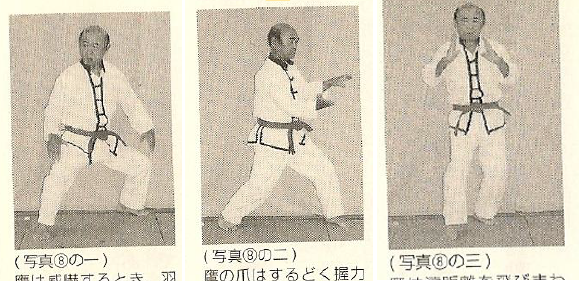Juhatsu Kyoda is someone who isn't spoken about much, despite being one of the most senior students of Kanryo Higaonna. He began his training with Kanryo in 1902, joining a few months before Chojun Miyagi. The two were considered brother disciples and can be seen in several early photographs training together. Kyoda is also said to have trained with Kanyu Higaonna and learned Seisan Kata from him too.
 |
| Juhatsu Kyoda |
There aren't too many stories of his training with Kanryo. The most famous one has to do with Sanseiru kata. Most people have heard this already, but it's said while Chojun Miyagi was away on military service, Kanryo Higaonna taught Sanseiru to Kyoda. Indeed, the Kyoda version of Sanseiru does have a number of key differences from Goju-Ryu.
Even after Kanryo Higaonna passed away, it seems Kyoda, Miyagi, Higa, Mabuni and others remained on friendly terms as they can be seen in several group pictures together from the 1920's time period. Around 1924, Kanki Izumikawa began learning Naha Te from Kyoda. At this time, neither Goju Ryu nor To'on Ryu were named yet.
Prior to this, Izumikawa mainly trained Shuri Te with his grandfather, who was a direct student of Sokon Matsumora. Izumikawa trained with Kyoda for about four years and appears to have learned Sanchin, Seisan and partially Sanseiru. I say partially because the Izumikawa Sanseiru kata has some traits of Kyoda's teachings, but it also has some techniques from the Goju-Ryu version.
This brings up another interesting question. It's often said that Kyoda never passed on the Kanryo version of Seisan. Indeed it seems his students on the mainland only learned the Kanyu version. However, if Kanki Izumikawa learned Seisan, then he may have learned the Kanryo version. The kata is close to Seiko Higa's but contains a few key differences.
While Kanki Izumikawa later moved to the mainland in 1939, there was still contact and communication with Kyoda, who also lived on the mainland. In 1958, Kanki Izumikawa sent Keisetsu Yoshimaru, one of his senior students to Beppu to train with Kyoda. Yoshimaru received additional corrections on Sanseiru and other kata which he then presented upon his return to the Senbukan.
Ultimately, both Juhatsu Kyoda and Seiko Higa had a rather big influence on Kanki Izumikawa's teachings. This also explains why his kata aren't quite like the Shodokan as well, because Seiko Higa wasn't his only teacher. One of the techniques in the Senbukan Gekisai Nidan (which Kanki Izumikawa created as his own version Of Gekisai Ni), was taken from Kyoda's Kanyu Seisan. Since Kanki Izumikawa trained under two students of Kanryo Higaonna, it can be said he preserved the old ways of Naha Te, with techniques not seen in other Goju-Ryu schools.
 |
A comparison of the same technique in Izumikawa's
Gekisai and Tou'on Ryu Seisan |








